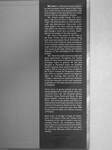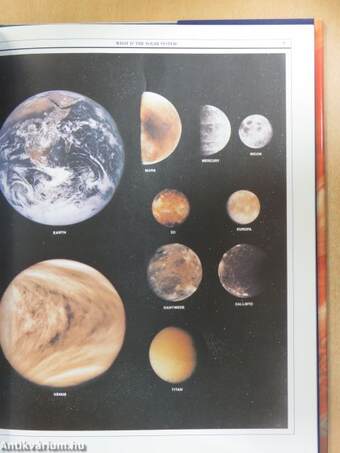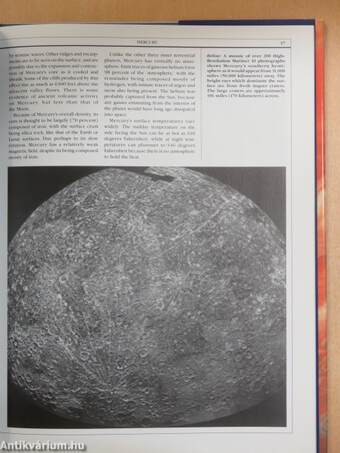1.119.492
kiadvánnyal nyújtjuk Magyarország legnagyobb antikvár könyv-kínálatát
Solar System
| Kiadó: | Crescent Books |
|---|---|
| Kiadás helye: | New York |
| Kiadás éve: | |
| Kötés típusa: | Varrott keménykötés |
| Oldalszám: | 79 oldal |
| Sorozatcím: | |
| Kötetszám: | |
| Nyelv: | Angol |
| Méret: | 31 cm x 24 cm |
| ISBN: | 0-517-06528-2 |
| Megjegyzés: | Színes és fekete-fehér fotókkal, illusztrációkkal. |
naponta értesítjük a beérkező friss
kiadványokról
naponta értesítjük a beérkező friss
kiadványokról
Fülszöveg
SOLAR SYSTEM
Bill Yenne
with 100 color photographs
F\t hundreds of years mankind had believed in the cosmology of five planets. Then, with the advent of telescopes, came the revelation that the Earth was a planet as well. So when Uranus, a heretofore unknown planet, was discovered beyond Saturn, the solar system expanded to become an almost limitless dimension. After Uranus two more planets were subsequently uncovered in the outer reaches of our solar system: Neptune in 1846 and Pluto in 1930. Neptune is twice as far from the Sun as Uranus, and Pluto, at its aphelion, is five times farther from the Sun than Saturn. What lies past Pluto's orbit is open to conjecture, but we can no more say that Pluto is the outermost planet of the Solar System today than Galileo should have said that of Saturn four centuries ago.
To the ancients, the planets were the •wanderers," the 'stars' that appeared to move most quickly across the heavens. Except for the Sun and Moon, they were also the... Tovább
Fülszöveg
SOLAR SYSTEM
Bill Yenne
with 100 color photographs
F\t hundreds of years mankind had believed in the cosmology of five planets. Then, with the advent of telescopes, came the revelation that the Earth was a planet as well. So when Uranus, a heretofore unknown planet, was discovered beyond Saturn, the solar system expanded to become an almost limitless dimension. After Uranus two more planets were subsequently uncovered in the outer reaches of our solar system: Neptune in 1846 and Pluto in 1930. Neptune is twice as far from the Sun as Uranus, and Pluto, at its aphelion, is five times farther from the Sun than Saturn. What lies past Pluto's orbit is open to conjecture, but we can no more say that Pluto is the outermost planet of the Solar System today than Galileo should have said that of Saturn four centuries ago.
To the ancients, the planets were the •wanderers," the 'stars' that appeared to move most quickly across the heavens. Except for the Sun and Moon, they were also the brightest objects in the sky, and thus were frequently visible in daylight as well as in the dark of night. In the earliest times there were five 'wanderers,' and each was invested with a rich and complex mythology. Many cultures named them for their favorite gods, and some even felt that they were the gods. The Sun, the Moon, and the planets stirred the imagination of earliest mankind, and they inspire the poet in us today.
Like our own Earth, each of the planets is a unique, dynamic world unto itself, with distinct features and as yet unsolved mysteries. Solar System is a capsule view of the best images available of those nine worlds, as seen through the most highly developed telescopes and from the spacecraft which have been sent to explore them over the past three decades.
Informative as well as beautiful. Solar System gives a detailed description of the physical characteristics of the planets, explaining the composition, size, temperature, surface, and atmosphere of each one. The awesome scenery of worlds we can but dream of visiting comes to life through richly colored photographs. This unique travelog of the planets and their moons takes the reader on an incredible journey through the solar system.
-m
Bill Yenne is a lifelong aerospace enthusiast and aerospace writer based in San Francisco, where he has worked as an author and book designer for the past 19 years and where he lives with his wife and two children.
Mr. Yenne's works include The Aslro-nauls: The Firs! 25 Years of Manned Space Flight: The Pictorial History of World Spacecraft: and Interplanetary Spacecraft, a detailed guide to the inner workings of spacecraft such as the Mariners, Pioneers, Vikings and Voyagers which have so greatly expanded our knowledge of the solar system.
Mr. Yenne is the author of The Atlas of the Solar System and the co-author, along with noted astronomer Kevin Krisciunas, of The Atlas of the Universe. Ideal companions to this colorful volume, these books contain maps of all the major solid-surfaced planets and moons in the solar system and detailed diagrams of the cosmology of the universe beyond.
Mr. Yenne has made numerous radio talk show appearances throughout the United States in recent years to discuss his work and aerospace topics in general. He has also designed or illustrated nearly one hundred books including those mentioned above. In August 1989 he was one of those on hand at the NASA/Caltech Jet Propulsion Laboratory (J PL) as scientists received and began to digest the startling data returned by the Voyager 2 spacecraft as it sped past Neptune in the last encounter on the most important exploration of the solar system in the history of mankind.
Front cover: A group portrait of the nine known planets of our solar system. They are, clockwise from top: the terrestrial planets (Mercury, Venus, Earth and Mars), the gas giants (Jupiter, Uranus and Neptune) and Pluto. The terrestrial planets and Pluto are depicted here much larger than their true sizes relative to the gaseous planets. In fact, Jupiter's volume is so great that more than 1000 Earths could fit inside of it! (Photo courtesy of NASA)
Bacli cover: A Voyager 2 image of Jupiter, from 3.72 million miles (six million km). Prominent in this view is Jupiter's most outstanding feature, the atmospheric phenomenon known as the Great Red Spot (GRS). The GRS is a cyclonic storm that has raged for more than 300 years. (Photo courtesy of NASA)
Vissza



















